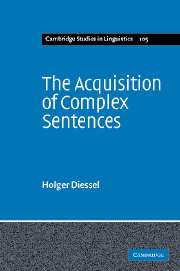Book contents
- Front matter
- Contents
- Figures
- Tables
- Acknowledgements
- Abbreviations
- 1 Introduction
- 2 A dynamic network model of grammatical constructions
- 3 Towards a definition of complex sentences and subordinate clauses
- 4 Infinitival and participial complement constructions
- 5 Complement clauses
- 6 Relative clauses
- 7 Adverbial and co-ordinate clauses
- 8 Conclusion
- Appendix
- References
- Author index
- Subject index
3 - Towards a definition of complex sentences and subordinate clauses
Published online by Cambridge University Press: 22 September 2009
- Front matter
- Contents
- Figures
- Tables
- Acknowledgements
- Abbreviations
- 1 Introduction
- 2 A dynamic network model of grammatical constructions
- 3 Towards a definition of complex sentences and subordinate clauses
- 4 Infinitival and participial complement constructions
- 5 Complement clauses
- 6 Relative clauses
- 7 Adverbial and co-ordinate clauses
- 8 Conclusion
- Appendix
- References
- Author index
- Subject index
Summary
Towards a definition of complex sentences
In this study complex sentences are defined as grammatical constructions that express a specific relationship between two (or more) situations in two (or more) clauses. The definition involves three important notions: (i) construction, (ii) situation, and (iii) clause. The notion of construction has been discussed in detail in the previous chapter; here I concentrate on the two other notions, situation and clause. My definition of these terms is based on Langacker's notions of process, which I call situation, and relational predicate (cf. Langacker 1991:chs. 5–7).
A situation is a conceptual unit that has two important properties: situations are relational and temporal. They can be seen as conceptualized scenes involving a set of entities that are arranged in a specific constellation or engaged in an activity. Situations can be divided into several types: (i) situations that are stative vs. situations that involve a change of state (e.g. The cat is sitting on the table vs. The cat is running); (ii) situations that are conceptually bound vs. situations that are conceptually unbound (e.g. The ball hit the wall vs. The ball is rolling); and (iii) situations that are punctual vs. situations that are temporally extended (e.g. He recognized the mistake vs. He learned how to play the guitar) (cf. Vendler 1967; Van Valin and LaPolla 1997). Situations must be distinguished from things. Things are nonrelational and atemporal. Like situations, they can be divided into several types, e.g. objects, persons, and places.
- Type
- Chapter
- Information
- The Acquisition of Complex Sentences , pp. 41 - 48Publisher: Cambridge University PressPrint publication year: 2004



